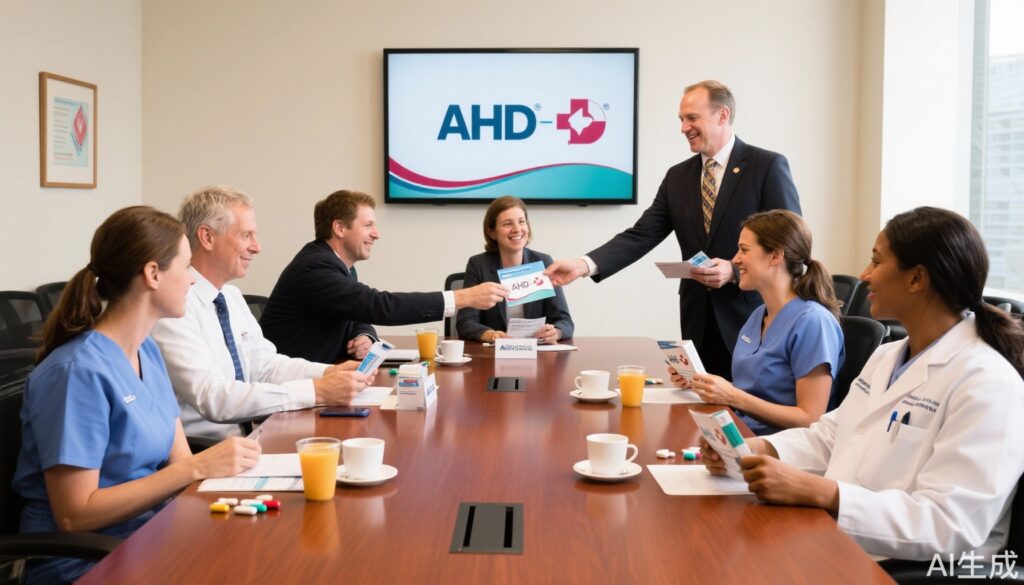Highlight
Manufacturers of ADHD medications more than doubled marketing payments to physicians from $1.8 million in 2021 to $3.6 million in 2023 and tripled payments to advanced practice clinicians from $500,000 to $1.6 million over the same period. Most payments were for food and beverages, with the highest marketing spend directed at the stimulant serdexmethylphenidate-dexmethylphenidate (Azstarys). A significant increase in ADHD stimulant prescriptions was noted between 2022 and 2023, raising concerns about whether marketing influences prescribing behavior and patient outcomes.
Study Background and Disease Burden
Attention-deficit/hyperactivity disorder (ADHD) affects an estimated 8.4% of children aged 2 to 17 in the United States, representing approximately 5.4 million children as per 2016 CDC data. ADHD is a chronic neurodevelopmental disorder characterized by inattention, hyperactivity, and impulsivity, significantly impacting academic, social, and family functioning. Pharmacologic treatment with stimulants and non-stimulants is a cornerstone of management alongside behavioral interventions. Despite established clinical guidelines, controversies persist regarding the appropriate prescribing rates of ADHD medications, especially amid concerns of underdiagnosing in some populations and overprescribing in others. The evolving scope of prescriptive authority—especially among nurse practitioners and physician assistants—adds another dimension to clinical practice patterns.
Study Design
The study, published in JAMA Pediatrics and conducted by Donahoe and colleagues at the University of Pittsburgh, analyzed marketing payments made to physicians and advanced practice clinicians (APCs) from 2021 to 2023 using data from the US Centers for Medicare & Medicaid Services. The analysis focused on specialties relevant to ADHD care, such as adolescent medicine, psychiatry, pediatrics, and family medicine. Payments were categorized by type—primarily food and beverages but also including travel, speaker fees, honoraria, consulting fees, and educational programs. The study also correlated marketing spending with specific ADHD stimulant drugs, identifying trends over time and differences between provider types.
Key Findings
Data revealed that manufacturers more than doubled payments to physicians from $1.8 million in 2021 to $3.6 million in 2023. Concurrently, payments to APCs tripled from $500,000 to $1.6 million, with a particularly striking 300% increase directed toward nurse practitioners. Among specialties, adolescent medicine physicians reported the highest receipt of marketing payments (just over 10%), followed by adolescent psychiatry (9.9%) and pediatrics (8.2%). Overall, physicians received approximately three times the total payments compared to APCs but the growth in APC-targeted marketing was markedly rapid.
The overwhelming majority (98.7%) of payments were for food and beverages, suggesting promotional meals remain the dominant marketing strategy. The ADHD medication receiving the highest marketing investment was serdexmethylphenidate-dexmethylphenidate (Azstarys), a stimulant approved by the FDA in 2021.
Correlating prescription trends with marketing spending, IQVIA data indicated a 60% increase in stimulant prescriptions between 2012 and 2022, with a notable 18% rise between 2022 and 2023 alone. This suggests a recent surge in ADHD medication dispensing temporally aligned with increased marketing payments.
A meta-analysis of 18 studies reported that 19.1% of children and adolescents diagnosed with ADHD received pharmacologic treatment, while 0.9% of those without diagnosis also received medication, leaving the balance of under or overprescribing unclear. Past reviews have linked overuse to economic drivers influencing clinician behavior, whereas underuse may stem from misconceptions about treatment risks or efficacy.
Expert Commentary
J. Travis Donahoe, PhD, MPH, lead author, emphasized that while marketing payments are not inherently problematic—given some promotional activities may be educational—the critical issue is whether increased prescribing driven by such payments translates to meaningful clinical benefit or results in overprescribing.
This perspective aligns with existing concerns in the literature about pharmaceutical marketing’s influence on prescribing practices. For example, research has shown that even small gifts or meals can subconsciously affect clinician decisions. Moreover, the tripling of payments to APCs coincides with expanded prescriptive authority for nurse practitioners, suggesting targeted marketing is adapting to evolving healthcare delivery models.
Clinical guidelines, such as the American Academy of Pediatrics 2019 ADHD guideline, recommend behavioral interventions for younger children and judicious use of FDA-approved medications in school-age children and adolescents, highlighting the importance of a balanced, evidence-based approach to ADHD management. The rapid increase in stimulant prescribing merits further investigation to rule out potential overprescribing or misuse, particularly in populations without confirmed diagnosis.
Conclusion
The significant increase in marketing payments to clinicians—especially advanced practice clinicians—by ADHD drug manufacturers highlights an important and evolving dynamic in ADHD care. While promotional efforts may support educational initiatives, the magnitude of financial incentives raises questions about potential impacts on prescribing behaviors and the risk of overmedication.
Future research should focus on delineating the causal relationship between marketing exposure and prescribing patterns and evaluating the clinical outcomes of increased stimulant use. Policymakers and healthcare organizations may consider monitoring pharmaceutical marketing influences and reinforcing adherence to ADHD treatment guidelines to ensure optimal patient care.
References
1. Donahoe JT, et al. Marketing Payments for ADHD Medications to Physicians and Advanced Practice Clinicians in the US, 2021-2023. JAMA Pediatrics. 2024.
2. Centers for Disease Control and Prevention. Data & Statistics on ADHD. Updated 2016.
3. American Academy of Pediatrics. ADHD: Clinical Practice Guideline for Diagnosis, Evaluation, and Treatment, 2019.
4. Cortese S, et al. Pharmacological Treatment of ADHD: A meta-analysis of efficacy and safety. Lancet Psychiatry. 2021;
5. IQVIA Institute. Use of Stimulants in ADHD: Trends Report. 2023.
6. Wazana A. Physicians and the pharmaceutical industry: is a gift ever just a gift? JAMA. 2000;283(3):373-380.
7. Sinha V, Jindal R. Marketing by pharmaceutical firms and prescribing decisions of physicians: a systematic review. Indian J Pharmacol. 2015;47(4):333-338.



